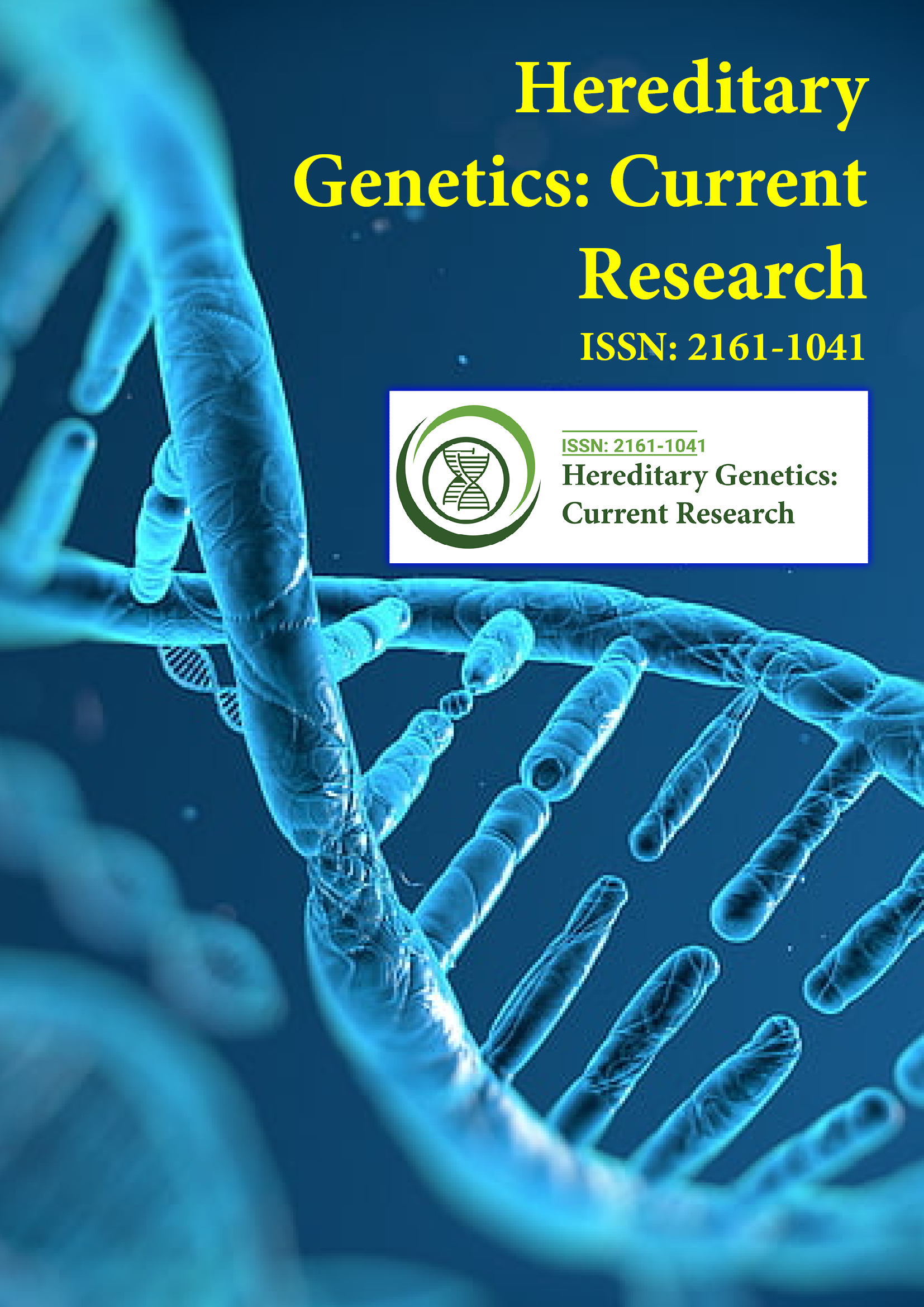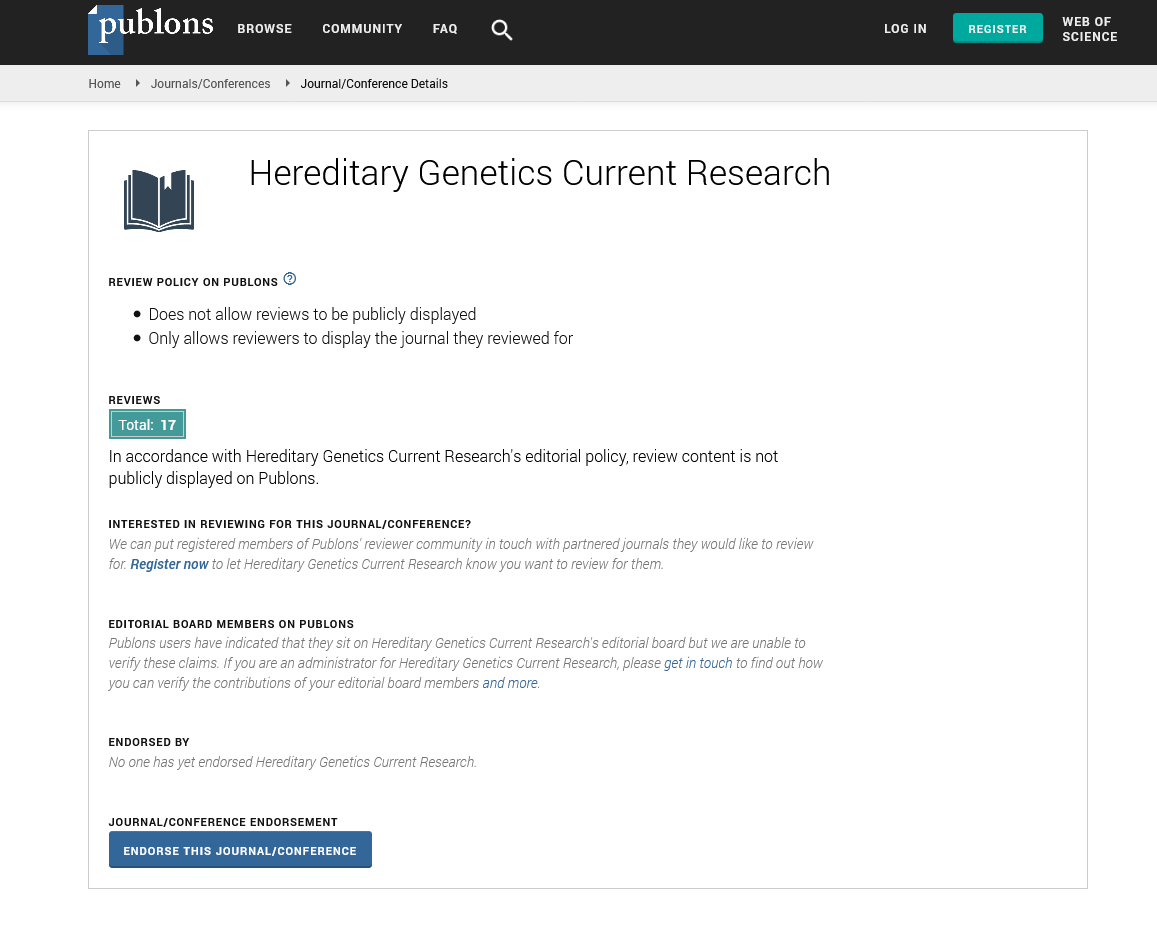Indexed In
- Open J Gate
- Genamics JournalSeek
- CiteFactor
- RefSeek
- Hamdard University
- EBSCO A-Z
- NSD - Norwegian Centre for Research Data
- OCLC- WorldCat
- Publons
- Geneva Foundation for Medical Education and Research
- Euro Pub
- Google Scholar
Useful Links
Share This Page
Journal Flyer

Open Access Journals
- Agri and Aquaculture
- Biochemistry
- Bioinformatics & Systems Biology
- Business & Management
- Chemistry
- Clinical Sciences
- Engineering
- Food & Nutrition
- General Science
- Genetics & Molecular Biology
- Immunology & Microbiology
- Medical Sciences
- Neuroscience & Psychology
- Nursing & Health Care
- Pharmaceutical Sciences
Short Communication - (2022) Volume 11, Issue 3
Examining the Impact of COVID-19 Spike Protein Mutations on the Human Cell Receptors
Camila Pinto*Received: 02-May-2022, Manuscript No. HGCR-22-17210; Editor assigned: 06-May-2022, Pre QC No. HGCR-22-17210 (PQ); Reviewed: 26-May-2022, QC No. HGCR-22-17210; Revised: 02-Jun-2022, Manuscript No. HGCR-22-17210 (R); Published: 09-Jun-2022, DOI: 10.35248/2161-1041.22.11.213
Description
The positive-polarity single-stranded RNA genome of the novel Coronavirus SARS-CoV-2 belongs to the corona viridae family. A comparative investigation with Coronaviruses of various strains, including MERS-CoV, SARS-CoV1, and Pangolin Coronavirus, in order to disclose the evolution mechanism of the SARS-CoV2 genome, in particular its spike protein, which is the primary driving force for host recognition [1].
In order to comprehend how this novel virus evolved throughout its transmission, a comparative analysis of freshly sequenced SARS-CoV2 from various parts of the world has also been done. The most recent France HCoV strain was the least similar to the reference among all sequenced viruses. In the Chinese province of Hubei's city of Wuhan, an outbreak of pneumonia that appeared to be viral but had no recognized cause, identified in December 2019 [2].
The discovery of a brand-new coronavirus was made public by the Chinese government's health officials and the World Health Organization (WHO) on January 9, 2020 (First named 2019- nCoV, then officially SARS-CoV-2, which differs from the viruses SARS-CoV1, responsible for the SARS outbreak in 2003, and MERS-CoV, responsible for an ongoing outbreak that began in 2012 in the Middle East). The organisms that causes Covid-19, an infectious respiratory disorder, is this novel virus (Coronavirus Disease). A small percentage of the severe acute respiratory syndrome coronavirus 2 (SARS-CoV-2) genome mutations will affect functional properties and may change infectivity, disease severity, or interactions with host immunity, even though most mutations in the SARS-CoV-2 genome are predicted to be either deleterious and quickly purged or relatively neutral. After the SARS-CoV-2 outbreak in late 2019, there was an 11-month stretch of relatively evolutionary stability. However, starting late 2020, a group of changes known as "variants of concern" have started to develop in the SARS-CoV-2 virus. These mutations influence virus properties like transmissibility and antigenicity.
This development is probably a response to the population's changing immunological profiles[3].
Most mutations found in genomes taken from circulating SARSCoV- 2 virions are anticipated to be either neutral or slightly harmful since highly unfavorable mutations are quickly purged. This is due to the fact that tolerated low-effect or no-effect "neutral" amino acid alterations are more common than higheffect mutations that affect viral adaptation and fitness do occur. It is anticipated that, in at least some situations, a tiny percentage of mutations will alter the virus phenotype in a way that offers a fitness advantage. Such alterations may change the pathogenicity, infectivity, transmissibility, and/or antigenicity of viruses, among other elements of their biology. Fitnessenhancing mutations were first discovered to have developed within a few months of the evolution of SARS-CoV-2 within the human population, albeit care must be given to distinguish between mutations that are merely present in increasing lineages and mutations that modify virus biology. For instance, the global SARS-CoV-2 population has seen many occurrences of the spike protein amino acid change D614G, and the coding sequence has a high dN/dS ratio, indicating positive selection at codon position 614. A moderate benefit for infectivity and transmissibility is conferred by D614G, according to later investigations [4].
This virus targets numerous host cell receptors, including ACE2. Understanding the ACE2 receptor's binding affinities is crucial for comprehending the viral process. Multiple changes in the French Strain S protein affected its affinity for ACE2 receptors. The 'Best-Fit' activity of COVID-19 has to be studied in more detail by future work involving the modeling of Spike proteins and experimental validation [5].
REFERENCES
- Hoffmann M, Kleine-Weber H. A multibasic cleavage site in the spike protein of SARS-CoV-2 is essential for infection of human lung cells. Mol Cell. (2020); 78:779-784.
[Crossref],[Google Scholar],[PubMed]
- Watanabe Y, Allen D, Wrapp D, McLellan J. Site-specific glycan analysis of the SARS-CoV-2 spike. Sci. (2020);369-370.
[Crossref],[Google Scholar],[PubMed]
- Mahase E. Covid-19: Where are we on vaccines and variants? Br Med J. (2021);372.
[Crossref],[Google Scholar],[PubMed]
- Garcia B, Evan C. Lam, Kerri St. Denis, Adam D. Nitido, Zeidy H. Garcia, Blake M. Hauser,et al. Multiple SARS-CoV-2 variants escape neutralization by vaccine-induced humoral immunity. Cell.(2021).
[Crossref],[Google Scholar],[PubMed]
- Letko M, Marzi A, Munster V. Functional assessment of cell entry and receptor usage for SARS-CoV-2 and other lineage B betacoronaviruses. Nat Microbiol. (2020);5:562-569.
[Crossref],[Google Scholar],[PubMed]
Citation: Pinto C (2022) Examining the Impact of COVID-19 Spike Protein Mutations on the Human Cell Receptors. Hereditary Genet. 11:213.
Copyright: © © 2022 Pinto C. This is an open access article distributed under the terms of the Creative Commons Attribution License, which permits unrestricted use, distribution, and reproduction in any medium, provided the original author and source are credited.

